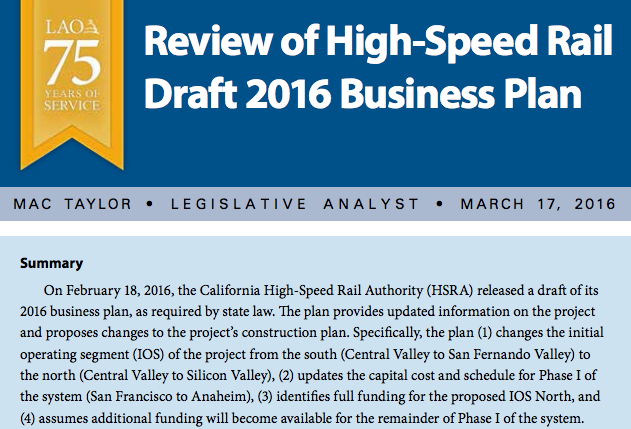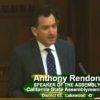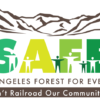Tip Toeing around the Authority’s newest business plan: The Legislative Analyst Report
The Legislative Analyst’s office, whose job is to be an impartial consulting group for the state legislature, published their opinion about the High-Speed Rail’s 2016 draft business plan. There are some strong words in their newest document but frankly, after the Legislature ignored their warnings and funded the Rail Authority’s first segment anyway in July 2012, it won’t seem to matter.
The LAO’s continues to question the funding and addresses the elephant in the room, where is the funding for the rest of the project. Their critique says this, “While the draft plan identifies funding sources to complete the proposed IOS North of Phase I, as well as meet certain costs for the bookends of the system, the plan does not identify specific funding to support the construction of the remainder of Phase I.”
They state: “This would mean that the state would need to identify additional funding sources in the future to pay for the $43.5 billion in construction costs for other segments of Phase I, in addition to any financing costs that might be required.”
Also in regard to funding on page 7 of the LAO opinion they count the Prop 1A funds as funds the Authority “has.” To make it completely clear, they don’t have these funds and the Authority can’t get these funds until they complete the second funding plan. They can’t do the second funding plan until they finish all environmental work and can show the funds for the entire segment, they must comply with A-K requirements under section 2704.08 of the enabling legislation called AB 3034. This includes proving they have sufficient ridership to make the segment financially viable. There’s a real question mark if San Jose to Shafter will have the millions of eager riders to sustain that segment. The Authority estimates IOS North would carry between 2.2 million and 4.1 million passengers per year.
In addition the LAO questions using the city of Shafter as the temporary southern terminus outside of Bakersfield since there is no commercial development for riders. The Bakersfield Californian personnel taped this YouTube of the site of the station at Shafter. It’s nowhere.
Most importantly, the LAO points out there was no environmental clearance for a station, temporary or otherwise in the environmental studies. That’s very important.
They point out that the Authority will seek federal funding for $2.9 billion in additional funding to expand their initial operating segment to Bakersfield and San Francisco. It’s $2 billion in costs to get the IOS to Bakersfield and they point out the $900 million which the Authority allocated to San Francisco would not fund the entire segment. They are completely right, the funding will only bring the train to Caltrain’s stop at 4th and King, not the Transbay Terminal. The connection from 4th and King to Transbay, though a very short 1.3 miles is estimated to cost $3-4 billion alone.
If the feds don’t come up with the money, the LAO suggests that the Legislature might “make it a priority to identify” another $2 billion to get to that southern station to Bakersfield. This is very unlikely to happen.
For the record, the LAO refers to the Initial construction segment (ICS.) There is no such thing as an Initial construction segment. This label of ICS that is the 118 miles of land, which used to be 130 miles, was invented by the Authority to accommodate the Authority’s lack of funding for the entire initial operating segment (IOS) required in Prop 1A. They seem to say, let’s build a little bit at a time since we have only $6 billion not $20, $30 or in fact $40 billion required to build a first initial operating segment. But let’s be clear, they don’t even have the $6 billion, since $2.7 of it are in Prop 1A bond funds, totally inaccessible to the Authority since they have not complied with the bond measure provisions. They have not shown in a 2nd funding plan that they have a plan, which conforms with Prop 1A proving that they have a viable segment. This was a successful outcome of the first Tos/Fukuda/Kings County case, which was not overturned.
The LAO fails to point out that in the business plan, the Authority must report on the costs for the entire system, not just phase one, (Los Angeles to San Francisco) but in addition phase two which covers service into San Diego and Sacramento. The Authority hasn’t done this for years and said at a recent board meeting they are considering this in the final business plan.
At the end of their review they suggest that “the Legislature will want to consider requiring future business plans to include all costs associated with the planned system and construction of the various segments, such as financing and administrative costs.”
While the LAO is at it, they might recommend the Legislature get an accounting of the following provision in the bond act. It says the Authority can spend a maximum of 10% of high-speed rail bond proceeds for environmental studies, planning, and preliminary engineering activities and that not more than 2.5% of high-speed rail bond proceeds be used for administrative expenses, except as specified.
Perhaps the LAO and even the state auditor should inquire whether the Authority is close to their maximum in administrative and planning expenses. No one knows for sure where their numbers are but being years behind in planning, they’ve got to be close to hitting the wall.
The LAO believes that the Legislature has to weigh in on the construction of the first segment, heading north instead of to Southern California, which was originally planned. They want to make sure whatever the Authority builds has stand-alone value. For the use of federal funds, proof of independent utility is required, however, to use state funds, there’s a whole set of specific hurdles called the A-K requirements under section 2704.08 of enabling legislation called AB 3034. which includes proof of financial independence for the segment they are building. These provisions take care of the proof of stand-alone value but in a more defined way.
The LAO does not mention that in order to execute the bookend funding using Prop 1A funds for the building of High-Speed Rail, not connectivity monies, the Authority must have a funding plan if it plans to dole out $500 million to Southern California and $600 million to Caltrain in the Bay Area. Again, though these are appropriated funds, the Authority cannot spend those funds unless they are being funded behind the scenes using other state monies as a loan. There are alternate ways provided in the bond measure such as section 2704.16. in AB 3034. The board may request the Pooled Money Investment Board to make a loan from the Pooled Money Investment Account, in accordance with Section 16312 of the Government Code,
The LAO believes that the Authority’s move to go toward San Jose as opposed to Central Valley to the San Fernando Valley is a good idea since they clearly did not have the money to go to Southern California. But despite the fact the Authority decided to head north and has limited funding, they are still determined to obtain environmental clearance for the Southern route of Palmdale to Burbank, much to the distress of Southern California neighborhoods. See the LA Times article summing up the issues surrounding their strategy.
Cap-and-Trade dollars needed:
The LAO says “If the legal uncertainty around the continuation of cap-and-trade is resolved [there are two lawsuits] in the short-run HSRA’s estimate of $500 million annually from cap-and-trade auction revenues (based on the 25 percent continuous appropriation) appears reasonable.”
“However,” they go on to say, “in order to help facilitate the long-run securitization of future cap-and-trade revenues as assumed in the plan, the Legislature would need to take steps to ensure the availability of an adequate amount of revenues to support such financing.” They continue, “For example, the Legislature could specify that the first call on annual cap-and-trade revenues would be for the repayment of high-speed rail financing. Such changes in the allocation of cap-and-trade auction revenues could impact the level of funding available for other programs intended to reduce GHG emissions.”
This isn’t going to happen. The environmentalists will be up on arms. There is a hint of it in this Wired article. Kathryn Phillips, director of the Sierra Club California, “wonders at the wisdom of putting cap-and-trade money into the high speed rail,” saying, “That money should be put into projects that get you near term emissions reductions as soon as possible.” So the idea to claim more for the project would obviously be distasteful.
And there’s hints of clear trouble in the state legislature too. During the hearings for the appropriation of 25% for the Rail program, June 15, 2014, author of AB-32, Senator Fran Pavley, repeated twice during her speech during the hearing that the High-speed rail project would get 25% of revenue in exchange for 1% of green house gas reductions. And then after those very carefully chosen words, she sat down and abstained voting as if politically gagged.
Watch Senator Pavley’s (D. Agoura Hills) and Pro Tem Kevin De Leon’s (D. Los Angeles) statements during the hearing that allocated the continuous 25% of cap-and-trade revenues for the high-speed rail project. Here’s the letter CEO Jeff Morales wrote to Senator Pavley prior to the vote. It emphasized use of the cap-and-trade for local development for local transit in the southern California as well as Caltrain development.
Note again, there is not enough money to spread cap-and-trade’s expected $500 million per year to match federal grant funds, to fund the Initial Operating Segment north, to fund early Southern California commitments and to fund Caltrain in the Bay area plus the entire rest of Phase one.
Speaker of the Assembly Toni Atkins (San Diego) attempted to extend AB 32 beyond 2020 through AB 1288. That bill dramatically changed by the time it passed, losing the part which extended cap-and-trade beyond 2020. The votes were not there to pass it.
While there is a bill currently circulating now which will eventually readdress this issue, Sacramento sources say it will be introduced requiring only a majority vote, which will not address the legal issues, one being that this is really a tax and therefore requires a 2/3 vote. This clearly points to trouble down the road for the rail project, which currently plans on decades of revenue originating from cap-and-trade funding.
Needless to say, giving more cap-and-trade for the rail program to secure loans for the high-speed rail project will have little chance of passage.
Quietly making changes:
The LAO states that “the information provided by HSRA in the business plan and other documents can be difficult to compare over time. For example, since beginning work on the initial construction segment (ICS), the scope, cost, and schedule of the project has changed, making it difficult to determine how well HSRA is adhering to the budget for that segment. Specifically, the length of the ICS was reduced to 118 miles from 130 miles. The projected cost of the ICS assumed in the draft 2016 business plan is $7.3 billion, compared to the initially planned $5.9 billion cost.”
This appears to be a trick that the Authority uses on a regular basis, in order to reduce costs. They reduce the miles, the scope, costs, snip here and snip there. For instance in Green Caltrain author Adina Levin points out, “The capital plan leaves out or defers a number of key investments on the Peninsula”:
- no funding for Caltrain capacity increases (longer platforms and longer trains), which will be needed to keep up with ridership growth in the early 2020s, and which HSR representatives had offered without commitments as compensation for supporting compatible platforms.
- reduced funding for the Downtown Extension to Transbay. The business plan appendix notes that the allowance toward DTX had been reduced by $1.5 billion, though there is a $550M allowance “for work done by others for Transbay connection.”
- up to $500 Million for grade separations on the Peninsula “that may be required as environmental mitigation” – but not until after 2030. (Note: There are 42 grade crossings in the stretch from San Jose to San Francisco)
- No funding for a mid-Peninsula station yet, even if a city wants a station.
Dan Walters, calls the project a moving target, in his latest opinion of the project after the release of the LAO’s report.
Years ago one Central Valley farmer told the Authority, “I think you’re trying to fake it until you make it.” Wise words that ring even more true today.
Please read the business plan for yourself and comment on their website by April 18, 2016. CHSRA Draft Business Plan
Besides this article including the LAO’s review, you can also read the two part analysis of the plan: The Hamilton Report: “Review of CHSRA 2016 Business Plan – Part 1” and: The Hamilton Report: “Review of CHSRA 2016 Business Plan – Part 2”





